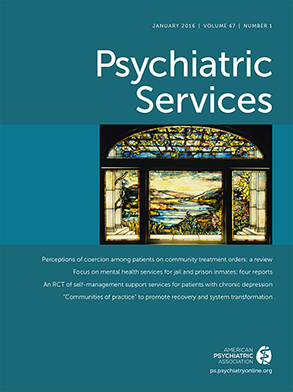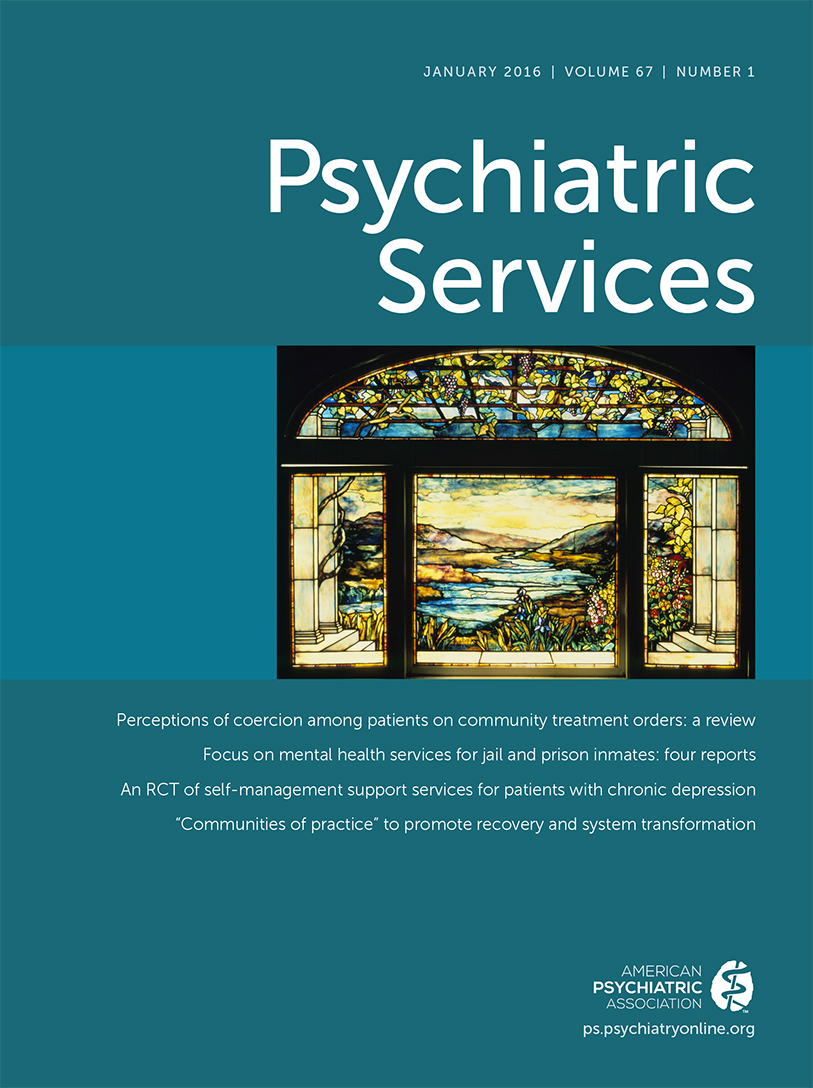Jail diversion is one of several strategies that prevent inappropriate arrest and detention or remove people with behavioral health problems from the criminal justice system prior to arraignment or sentencing. It is accomplished by diverting individuals to community-based treatment or rehabilitation or to other sentencing alternatives, such as probation, restitution, or community service (
1).
Studies have found high rates of traumatic experiences among a range of marginalized populations, including people with criminal justice involvement. Steadman (unpublished data, Steadman HJ, 2009) found that 95.5% of women and 88.6% of men in jail diversion expansion programs funded by the Substance Abuse and Mental Health Services Administration (SAMHSA) reported exposure to traumatic experiences prior to incarceration. Although exposure to trauma is common among American adults, only about 8.7% of the general population develops posttraumatic stress disorder (PTSD) (
2). In contrast, lifetime prevalence rates of PTSD among male (31%) and female (27%) military personnel are more than three times higher than in the general population (
3).
The most recent data indicate that veterans comprise 10% of the incarcerated population in state and federal prisons (
4). Compared with other inmates, veterans tend to be older, better educated, and less racially diverse (
4,
5). Although there is relatively little research on the effect of trauma on veterans’ justice system involvement, studies suggest that 50% or more of incarcerated veterans may meet criteria for a diagnosis of PTSD (
5,
6).
In recognition of the mental health needs and trauma experiences of justice-involved veterans, there has been an increase in criminal justice programming, such as diversion programs and specialty courts, targeted to veterans. The Jail Diversion and Trauma Recovery (JDTR) program, initiated in 2008 by SAMHSA, supported the implementation of jail diversion programs in 13 states for persons with PTSD and other trauma-related disorders who were involved in the criminal justice system, with a priority emphasis on veterans. Grantee programs focused on screening for PTSD and identifying veterans at various points along the criminal justice continuum. These programs were designed to reduce involvement with the criminal justice system through linkage with or provision of behavioral health treatment, including trauma-specific services.
Currently, women in the military are performing roles similar to those of men, making them more likely than ever to be exposed to stressful and traumatic experiences in both combat and living arrangements (
7). However, research addressing the needs of female veterans has been limited to descriptive studies of females in the military and their transition to civilian life after military service (
8,
9). In addition, few studies have examined the characteristics of female veterans with criminal justice involvement or explored the similarities and differences between male and female veterans who are involved with the criminal justice system. This report compares female and male justice-involved veterans enrolled in the JDTR program, identifying distinct attributes of female veterans that may be helpful to other veterans’ diversion programs in general—and, more specifically, to programs serving female veterans involved in the justice system.
Methods
Data were from the JDTR National Cross-Site Evaluation funded by SAMHSA, a multimethod process and outcome evaluation of the 13 grantees funded under the JDTR initiative. The main source of information about clients was individual, in-person interviews with JDTR program enrollees who voluntarily agreed to participate in the evaluation. Evaluation participants were recruited by local evaluators, each following informed consent procedures approved by their respective institutional review board (IRB). Deidentified client interview data were submitted to the cross-site evaluation and then combined into a complete data set. Procedures for the cross-site study received IRB approval.
Interviews were conducted with program participants at baseline (program enrollment). The instrument included items about demographic characteristics, income and education, behavioral treatment history, military service history, lifetime traumatic experiences, mental health and trauma symptoms, criminal justice history, behavioral health service utilization, and personal recovery. The PTSD Checklist–Civilian Version (PCL-C) (
10) was used to document trauma symptoms. The 24-item version of the Behavior and Symptom Identification Scale (BASIS-24) was used to assess global mental health and six specific dimensions of mental health, including depression and substance abuse (
11). Information about military trauma was collected at a six-month follow-up interview to minimize respondent distress at program enrollment.
Data were prepared and analyzed by using Stata SE, version 12. A two-tailed Fisher’s exact test was used to test differences in dichotomous variables between female and male participants. A two-tailed independent samples t test was used to test differences in continuous variables between the groups.
Results
Between January 2009 and April 2014, a total of 1,284 of the 1,714 participants (74%) across the 13 grantees in the JDTR program agreed to participate in the evaluation. There were no substantive demographic differences between those who did and did not agree to participate in the evaluation, after population differences between sites were taken into consideration. The sample for this analysis comprised the 1,025 participants who had served in the U.S. military. We did not use data from four grantee sites that did not enroll any female veterans.
Although only a small percentage of the sample was female (7%, N=69), there were few statistically significant differences between the female and male participants in a range of areas, including demographic characteristics and military experience. [A table summarizing the characteristics of male and female veterans in the JDTR program is available as an
online supplement to this article.] A little more than two-thirds of all participants were white (69%, N=708), 10% (N=103) were Hispanic, and the average age was around 40. Slightly less than a third of participants were employed part-time or full-time at enrollment (31%, N=317), and a similar percentage (32%, N=323) received income from veteran benefits. Seventeen percent (N=176) had been primarily homeless in the past 30 days. The only demographic variable that approached significance was that female participants were more educated; 68% of female veterans had at least some college education, compared with 54% of male veterans (p=.070) (
Table 1).
In terms of military experience, approximately 90% (N=920) of all participants were separated from the military; more than 62% had been discharged for more than five years (N=634). All of the female participants and 97% (N=932) of the male participants had received an honorable or general discharge. There were no statistically significant differences between the groups in branch served; 63% served in the Army (N=642) and 8% to 16% each in the Navy (N=166), Marines (N=152), and Air Force (83). However, only 1% (N=1) of female JDTR participants had served in the Vietnam era, compared with 17% (N=159) of male JDTR participants. Eighty percent (N=824) of all participants felt that their military service had contributed to mental health or emotional problems; about a third of both groups had a service-connected disability as determined by the U.S. Department of Veterans Affairs (N=323).
Both males (96%, N=917) and females (99%, N=68) reported nearly universal rates of nonmilitary trauma, a finding largely related to the enrollment criteria for many of the programs. However, there were differences between the groups in the rates of military trauma. Given that the restrictions on females serving in combat roles were lifted only recently, a smaller percentage of female veterans (38%) had served in a combat zone compared with their male peers (58%). At the six-month interview, respondents (N=657) were asked about sexual assault in the military, and those who had served in a combat zone were asked about types of military trauma. Among respondents who served in a combat zone at six months (N=392), there were no statistically significant differences between genders in terms of reporting any combat trauma. Nearly all male veterans (96%, N=358) and female veterans (90%, N=19) reported some type of combat trauma; however male veterans were more likely than female veterans to have experienced specific types of trauma, including being attacked or ambushed, being shot at or directing fire at the enemy, and seeing someone seriously injured or killed (
Table 1).
The greatest difference between the groups in trauma exposure before and during military service had to do with sexual assault. More than half of female veterans (58%) who were interviewed at six months reported being sexually assaulted while in the military, compared with 5% of male veterans. The main gender difference in nonmilitary trauma was a significantly higher rate of lifetime sexual assault reported by females (68%) versus males (18%) (
Table 1).
Criminal justice involvement for males and females was also largely similar. Prior to involvement in the JDTR program, a majority of participants had an arrest history (86%, N=882), a little more than two-thirds (N=689) had been on probation or parole, and about half (N=518) had been incarcerated because of a conviction. However, the males were generally younger at their first arrest compared with the females (ages 24 and 29, respectively). Although not quite statistically significant, 17% of females (N=12) had been arrested before age 18, compared with 27% of males (N=261). In addition, a larger proportion of males than females reported having a past restraining order (prior to JDTR) (38% and 23%, respectively) or a current restraining order (N=200, 21%, and N=8, 12%, respectively).
The rates of mental health and substance use problems were high for both females and males, but female veterans had higher rates of mental health problems compared with males, and male veterans reported higher rates of alcohol use problems compared with females. More female veterans than male veterans had a history of mental health treatment prior to JDTR, met criteria for PTSD, and had moderate or extreme difficulty related to global mental health and depression. Female veterans also had higher symptom severity scores on the PCL-C (
Table 1). In contrast, males were more likely than females to report any alcohol use and heavy alcohol use in the past 30 days. However, there were no differences between females and males for illegal drug use, which was reported by slightly over one-third of the sample.
Discussion
This report provides a descriptive comparison of male and female veterans involved in criminal justice diversion programming. The focus on gender differences helps fill a gap in the literature. In general, the results of the analysis found that the female and male veterans participating in the JDTR program were largely similar. The major areas of difference were related to types of trauma (in particular, trauma caused by sexual victimization), mental health symptoms, and substance use. Although females were less likely than their male counterparts to have experienced combat directly during the course of their active military service, they appear to have entered and exited the military with a heightened level of trauma exposure.
Some of the limitations of this analysis included a small sample of females in the JDTR program and variations in recruitment and enrollment policies across the numerous grantee sites. In addition, the evaluation did not collect data about children or marital status, which are important variables, given that the literature on female veterans indicates that parenting and marital roles are a major burden following military deployment.
Conclusions
Comprehensive studies are needed on the quality of care and treatment for female veterans. Specifically, research on treatment for women in the military should control for socioeconomic status and compare treatment with that of nonmilitary peers (
9). Unfortunately, we were not able to do so because of the small population of female nonveterans (N=26) in this sample. We believe comparisons of lifetime rates of trauma, sexual assault, and mental health and substance abuse problems between female veterans and nonveterans to be a fruitful area for future research.

